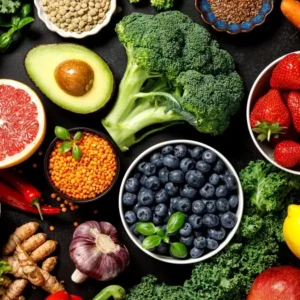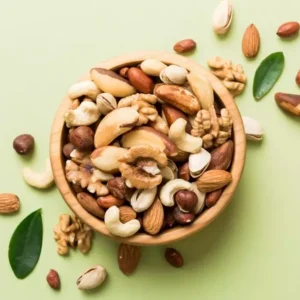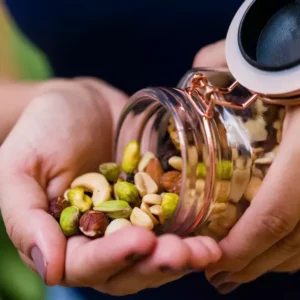Sodium is a mineral that plays an important role in the hydration state of the body. It is present in the blood and in the extracellular fluid in which cells are bathed. Sodium also helps maintain acid-base balance and is essential in the transmission of nerve impulses as well as muscle contraction. However, in excess it can have deleterious consequences. This is why current recommendations aim to limit sodium consumption.
Characteristics of sodium:
- Mineral with a very important role in the distribution of water in the body
- Influences blood pressure, transmission of nerve impulses and muscle contraction
- Found in large quantities in table salt, smoked products and in brine
- Sodium consumption should be limited
- In excess, sodium can be dangerous for arterial and kidney health
Why eat foods high in sodium?
Benefits and roles of sodium in the body
Water balance
The concentration of sodium in the body regulates the movement of water between the different intracellular and extracellular compartments. Through homeostasis and absorption phenomena, sodium in the right quantity is responsible for the body’s water balance.
Nerve impulses
The presence of sodium in the body makes possible the transmission of nerve impulses to neurons in the brain via polarization phenomena.
Muscle contraction
A sufficient amount of sodium also enables the muscle contraction mechanism.
Arterial pressure
Sodium is also involved in the regulation of blood pressure. Thus, high sodium consumption significantly increases blood pressure and vice versa. This is why, in cases of high blood pressure, a more or less sodium-free diet is often recommended.
What is the difference between sodium chloride, salt and sodium?
Salt is composed of chlorine and sodium, so it is also called sodium chloride. Sodium is therefore only one of the two salt compounds. 1g of salt contains 400 mg of sodium and 600 mg of chlorine. Conversely, it takes 2.5 g of salt to obtain 1 g of sodium.
20 foods rich in sodium
The main sources are prepared and prepackaged foods. In fact, more than 75% of the sodium we consume comes from processed foods such as cheeses, deli meats, pizzas, sauces and soups as well as dried or smoked foods.
| Food | Portions | Sodium content |
|
Miso, fermented products |
175ml (3/4 cup) |
7 583 mg |
|
Dehydrated Corned Beef |
100 g |
2 790 mg |
|
Table salt |
1 C. coffee |
2 373 mg |
|
Grilled Bacon |
100 g – 4 tranches |
2 310 mg |
|
Regular ham, 11% fat, sliced |
100 g |
1 500 mg |
|
Fish sauce ready to serve |
15 ml |
1 408 mg |
|
Baking soda |
1 C. coffee |
1 284 mg |
|
Sauce soya, shoyu et tamari |
15 ml |
914-1 038 mg |
|
Canned legumes |
1 tax |
718-873 mg |
|
Atlantic herring, marinated |
100 g |
870 mg |
|
Smoked salmon |
100 g |
784 mg |
|
Teriyaki sauce ready to serve |
15 ml |
700 mg |
|
Canned tomato sauce |
125 ml |
678 mg |
|
Reduced sodium soy sauce |
15 ml |
608 mg |
|
Canned anchovies |
4 anchovies (16 g) |
588 mg |
|
Dill Pickles |
1 pickle (65 g) |
569 mg |
|
Feta cheese |
50 g |
558 mg |
|
Canned sardines |
100 g (8 medium) |
505 mg |
|
Canned sauerkraut |
1/2 tax |
496 mg |
|
Fromage cottage, 2 % MG |
125ml (1/2 cup) |
485 mg |
Use of sodium
Current recommendations aim to limit salt consumption in the diet. Thus, men should not consume more than 8g of salt per day while women and children should limit their consumption to 6.5g of salt per day.
Concerning sodium, there are recommendations relating to sufficient intakes (AS) and tolerable maximum intakes (AMT).
|
Adequate intake (AS) |
Tolerable Maximum Intake (AMT) | |
|
Babies 0-6 months |
120 mg |
– |
|
Babies 7-12 months |
370 mg |
– |
|
Babies 1-3 years old |
1 000 mg |
1 500 mg |
|
Children 4-8 years old |
1 200 mg |
1 900 mg |
|
Boys 9-13 years old |
1 500 mg |
2 200 mg |
|
Girls 9-13 years old |
1 500 mg |
2 300 mg |
|
Boys 14-18 years old |
1 500 mg |
2 300 mg |
|
Girls 14-18 years old |
1 500 mg |
2 300 mg |
|
Men 19-50 years old |
1 500 mg |
2 300 mg |
|
Women 19-50 years old |
1 500 mg |
2 300 mg |
|
Men aged 50 and over |
1,300 and 1,200 mg if 70 years and over |
2 300 mg |
|
Women aged 50 and over |
1,300 and 1,200 mg if 70 years and over |
2 300 mg |
|
Pregnant women |
1 500 mg |
2 300 mg |
|
Breastfeeding women |
1 500 mg |
2 300 mg |
Carbonate, sodium bicarbonate, sodium citrate and other forms in food
Although sodium chloride is the main source of dietary sodium, other forms are often found in foods as additives (monosodium glutamate, sodium benzoate, sodium nitrite, disodium pyrophosphate etc.). Sodium bicarbonate and sodium citrate are found in many antacid-type medications.
Adverse effects of sodium
Consequences of a lack of sodium
Sodium deficiency is very rare. Even when dietary sodium intake is low, the body usually adapts by reducing losses through urine and sweat. On the other hand, a deficiency can occur during repeated vomiting, prolonged diarrhea, excessive sweating. Too little sodium intake can cause some harmful side effects. Symptoms of sodium deficiency are muscle cramps, loss of appetite, dehydration, drop in blood pressure and confusion.
Too high sodium level
Conversely, excessive sodium consumption, which is much more common, can also lead to adverse effects including high blood pressure and loss of bone mass (osteoporosis). High blood pressure is a major risk factor for stroke, heart disease, and kidney disease. The general population consumes much more sodium than their actual need. Indeed, the average consumption of sodium in the form of salt among the French is 2000 to 4800 mg per day. Individuals suffering from hypertension, diabetes or chronic kidney disease as well as the elderly are more likely than the rest of the population to have their blood pressure increased following a high sodium intake because they have a sensitivity to sodium. higher salt.
 Receive every day
Receive every day
advice from our experts
to take care of you

Interactions (with other nutrients)
A high potassium intake would increase the excretion of sodium in the urine and therefore attenuate the increase in blood pressure resulting from excessive sodium intake.
Chemical properties
The symbol for sodium is Na and its atomic number is 11. Its atomic mass is 22.98976928 u. In its natural state, it is a soft, silver-colored alkaline metal.
In the body, sodium is essential and occurs at many levels, often coupled with potassium. Thus, in the right quantity, it helps maintain homeostasis, fluid distribution, blood pressure, the functioning of the nervous system and muscle contraction.
Sodium hydroxide, also called caustic soda, is the solid form of sodium. Its chemical formula is NaOH. It is generally used to produce relatively harsh soaps, laundry detergents and other detergents.
Historical
Nutrient History
Sodium was isolated for the first time in 1807 by H. Davy, from sodium hydroxyl. In the Middle Ages, sodium was already part of the composition of remedies to treat headaches. We always find very high quantities of it in effervescent medicines.
For a very long time, salt has also been used to preserve food and enhance its taste. This explains, in part, its ever-increasing use by the food industries. Indeed, salt consumption continues to increase throughout the world, despite nutritional recommendations.
95% Readers found this article helpful And you ?
Was this article useful to you?












